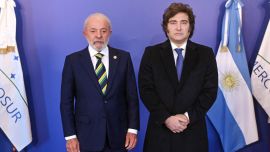This book is called “The harp and the ocean” (El arpa y el océano) in order to evoke its subject matter of Irish lives on the other side of the Atlantic, but its 14 short stories could equally well have been entitled “Historias mínimas” after the 2002 Carlos Sorín film because of its deceptive minimalism – the experiences of ordinary people doing nothing extraordinary although sometimes on the fringe of historical milestones.
Another alternative title could have been William Henry Hudson’s Far Away and Long Ago because with the exception of the concluding piece – atypical for both its length and content, being largely an extended discussion of philosophy, theology and literature at Notre Dame University with various scholars of Irish studies, including Mark Harman (brother of a previous Irish ambassador here, Justin Harman) – and another item centred on a recollection 40 years later of the 1976 massacre of the Pallottine priests in Belgrano, all the short stories date back nostalgically at least two generations with references to years ranging between 1843 and 1958 approximately.
In other words, Irish-Argentines at least as much the first half as the second half rather than the all too frequent experience today of nothing Hibernian other than an unmistakable surname (with Delaney himself an outstanding exception). Sometimes unaware even of that – thus a long time ago the poetess-singer María Elena Walsh said in an interview: “It’s funny that I’ve never liked the English much, having an English name myself.”
Something as mundane as a bus ride forms the thread of the narrative more than once and something as dreary as an old people’s home the backdrop, but these vignettes from the past are never aimless. Sometimes the story takes in a major historical event (the 1955 naval bombing of Peronist crowds in Plaza de Mayo or the 1848 execution of CamiIa O’Gorman and her priest lover by Juan Manuel de Rosas) or a famous literary figure like José Hernández of Martín Fierro fame or the playwright Eugene O’Neill docking here as a merchant seaman in 1910.
Although unlike most Irish immigrants elsewhere (thinking of Boston and New York City, for example), the newcomers here tended to be atypically drawn towards rural rather than urban destinations, given the abundance of fertile land so unavailable to them back home, but only four of the 13 short stories are set on the farm – the porteño Delaney stays in his comfort zone with at least as many stories having tango as a musical theme.
If there is one common denominator permeating this book, it is Irish Catholicism with hardly a short story without its church, religious school or pious character where the title is not already referential – 'El Padre Gannon,' 'El obispo' or 'Mea culpa.' Here Delaney takes a detached view, placing himself on both sides of the aisle without evading this fundamental issue – both an ancestral loyalty to a cultural tradition once lying at the core of identity and a note of scepticism allowed to creep into even those living in far more devout times.
Perhaps this little book can best be summed up as being the reverse of H.L. Mencken’s dictum: “Deep down he’s shallow.”






















Comments